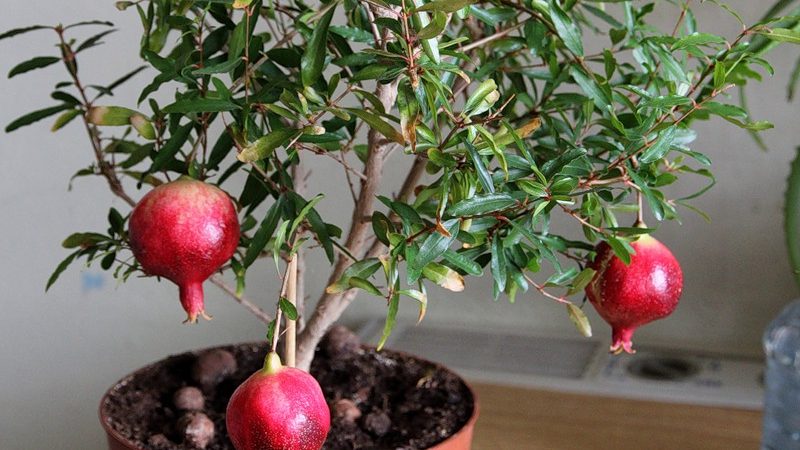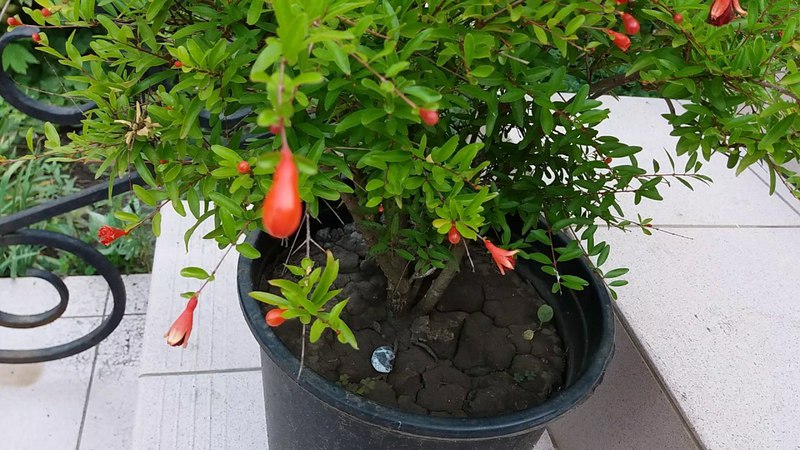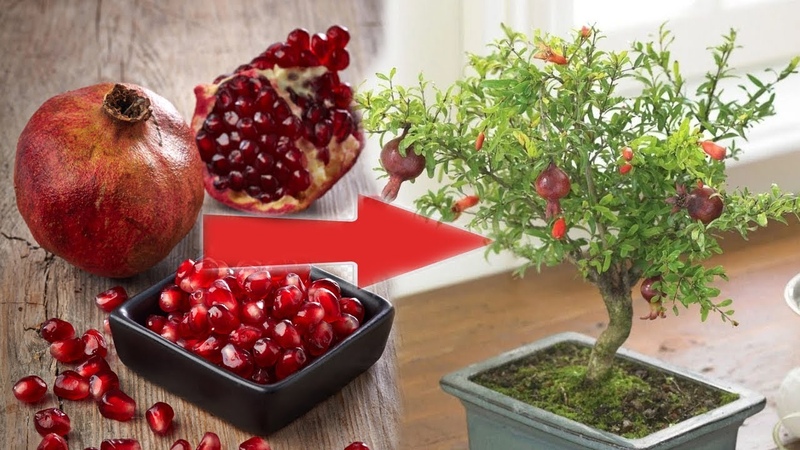How and what to feed pomegranate at home
Indoor pomegranate is an unpretentious plant that, with proper care, pleases with abundant flowering and fruiting. To prevent the tree from dying, it is important not only to choose a suitable soil and place in the house, but also to fertilize it regularly. In this article, you will learn how to feed pomegranates at home.
The content of the article
What does a home-grown pomegranate need?
For planting, you can buy ready-made seeds adapted for home conditions, or take them from a fruit purchased in a store. The rarest way to grow this plant in a room is by cuttings (cultivation from the twigs of a fruit tree).

To get a pomegranate tree with fruits, observe the row conditions for care behind him:
- Lighting. It is a very light-loving plant, so place it near windows on the south side. Protect young growth from direct sunlight.
- Temperature. For long and abundant flowering, provide the plant with a constant temperature of + 20 ... + 25 ° C from May to September. During fruiting, the pomegranate needs only + 12 ... + 16 ° C. In winter, in order for the plant to rest, remove it to a cool place with an air temperature of no more than + 10 ... + 12 ° C.
- Watering. When the plant is just gaining strength, water it abundantly. Reduce watering frequency during flowering, but make sure the soil does not dry out. During winter holidays, pomegranates almost do not need moisture, so water it once a week.
- Fertilizer. Feed the tree only during the flowering and fruiting period. You don't need to do this in winter.
- Air humidity... In summer, pomegranates need additional moisture, so on extremely hot days, spray it with a spray bottle.
- Protection from pests and diseases. To prevent the tree from suddenly dying, inspect it regularly. At the first signs of the appearance of insects or diseases, treat with special preparations.
- Transfer. This houseplant grows up to 2 m in height, so it is advisable to regularly transplant it into larger pots. Young pomegranate - once a year, an adult tree - at least once every 3 years.
- Pruning. Remove old branches annually in February.
To form the correct crown at grenadepinch the young plant regularly.
How often and when to feed it
For normal growth, pomegranates are regularly fed with nitrogen, organic and potassium-phosphorus fertilizers. The first time this is done during landing. It is imperative to comply with the recommended norms, especially during the flowering period, otherwise you can harm the plant.
The main emphasis on fertilization is done in the spring-summer period. Top dressing is applied at least 2 times a month, after watering. It is optimal to "feed" the pomegranate once a week, alternating various supplements.
In winter, during the dormant period, the tree does not need fertilization.
The best food for pomegranate

Top dressing is carried out in two ways - root and foliar. To do this, use different types of fertilizers - organic, mineral and folk remedies.
Organic
The peculiarities of using organic fertilizers are that they are applied to the soil only after watering. A big plus of this type of feeding is its nutritional value and environmental friendliness.
One of the most popular organic fertilizers is mullein infusion, which is diluted with water in a ratio of 1:10 before application.
The second most popular solution is chicken manure. He prepares as follows:
- Pour two parts of water over one part of the droppings.
- Close and put in a warm place for 2-3 weeks.
- Dilute the infusion with water in a ratio of 1:25.
- Before adding to the soil, make the solution even less concentrated - dilute again with water in a ratio of 3: 4.
In order not to damage the roots of the plant, you need to strictly follow the rules specified in the recipe.
Mineral
It is advisable to use mineral fertilizers if organic fertilizers do not have the desired effect or the soil is severely depleted. Such a top dressing cannot be applied to the soil; it is used only for spraying the plant.
Mineral fertilizers, depending on the composition, are divided into:
- potassium salts;
- superphosphates;
- phosphates;
- nitrogen.
During the flowering period, pomegranates are fertilized with phosphorus additives; during active growth, in spring, nitrogen fertilization is used. In autumn, the plant needs potassium and organic fertilizers.
Reference. Mineral fertilizers are sprayed on the tree only in cloudy weather or in the evening, otherwise the leaves may get burned.
Folk remedies
Folk recipes for fertilizing indoor pomegranate are a good alternative to mineral dressing.
Banana peel
An infusion or powder made from banana skins prevents deficiencies in potassium, magnesium and phosphorus.
For its preparation, the peel of one banana is poured into 1 tbsp. water and insist. Water the plant once a week.
The powder is very easy to prepare. Banana skins are dried, ground in a coffee grinder and the resulting powder is poured under the root.
Potato peelings
It is an excellent substitute for organic fertilizers - manure and chicken droppings. The preparation method is simple: pour boiling water over the cleaning, cool, filter and pour the pomegranate with the resulting solution.
Citrus peel
Any citrus fruit is used for the preparation of fertilizer - lemon, orange, tangerine, etc.
Cooking method:
- Take equal parts citrus peel and pomegranate.
- Pour hot water over them.
- Insist in a dark place for at least 3 days.
- Strain.
- Water the plant once a week.
Experienced flower growers recommend using the infusion on the peel of citrus fruits after winter rest, during the active growth of pomegranate.
How to feed pomegranates depending on the season and growth phase

If you take proper care of indoor pomegranate, it will delight not only with abundant flowering, but also fruiting.
After the cold season, in mid-spring, the pomegranate needs fertilizers with a high nitrogen content. It is during this period that it is in the stage of active growth of shoots and leaves.
For good development of buds and abundant flowering in the summer, the plant is fertilized with phosphorus fertilizers.
In the fall, when the fruits of the pomegranate are tied, the tree is fed with potassium compounds. They will not only provide good yields, but also strengthen the plant's immunity for the winter.
What to fertilize to grow a large pomegranate

If you do not properly care for the plant or do not use fertilizers, you can not wait for fruiting.
In order for the pomegranate to start fruit, give preference to organic fertilizers. Do not feed it too often, as the large amount of nitrogen will inhibit flowering and ovary. Enough 1-2 times a month.
Fertilization rules
To prevent depletion of the soil, pomegranates are fed every other day after each watering. When applying organic fertilizers to the soil, it is important to protect the trunk as they can damage the plant.
Top dressing scheme:
- from February to May - ammonium nitrate or urea;
- from May to the end of September - phosphorus supplements;
- from October to November - potash or organic fertilizers.
It is enough to fertilize a healthy young plant once every 2 weeks, a weakened tree - once a week.
It is interesting:
Step-by-step guide to propagating pomegranate cuttings at home.
Is there a pomegranate without seeds and how to distinguish it from the usual.
Is it possible to eat pomegranate at night and what harm and benefit from this can be.
Conclusion
The pomegranate is considered one of the most unpretentious decorative fruit trees. To obtain a crop, depending on the growth phase, it is important to ensure the optimal temperature regime, water it in a timely manner, feed and transplant it. If you follow all the care recommendations, the first fruits will appear as early as 3-4 years of plant life.